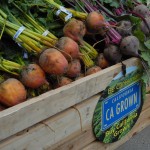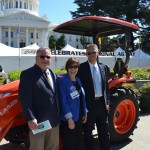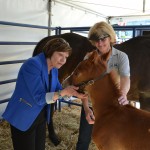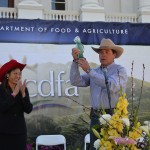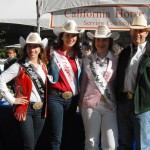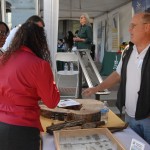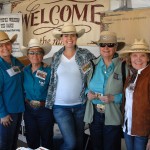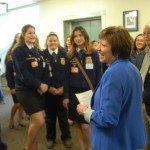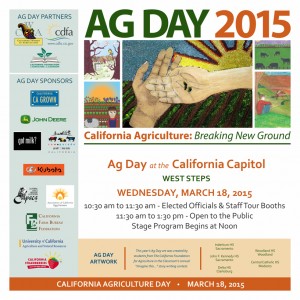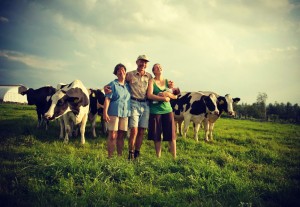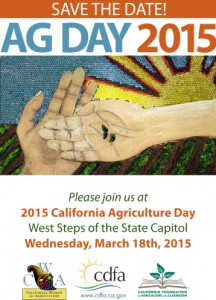-
Recent Posts
- CDFA’s Leslie Fernandez Wins ‘Women Making a Difference’ award
- Secretary Ross joins UC ANR to introduce California AgTech Alliance; funded by California Jobs First
- The Climate Resilience Strategy for California Agriculture is out for public review
- Agritourism – California’s Pumpkin Patches: Hunter Farms
- CDFA Undersecretary Christine Birdsong counts down California CRUNCH!
Recent Comments
- Micah on Secretary Ross on Water, Workforce, and the Future of California Agriculture — from AgNet West
- CA agriculture value surpasses $60B | Western Livestock Journal on Value of California Ag production tops $60 billion for first time
- Kathy de Contreras on CDFA IT department honored at “Best of California” awards
- El costo económico de las deportaciones masivas ya es visible en California - Espanol News on Nine California Counties Make Top-10 List for Ag Sales in the U.S.
- Deportations are taking a toll on California’s economy – and have only just begun – The News Beyond Detroit on Nine California Counties Make Top-10 List for Ag Sales in the U.S.
Archives
- October 2025
- September 2025
- August 2025
- July 2025
- June 2025
- May 2025
- April 2025
- March 2025
- February 2025
- January 2025
- December 2024
- November 2024
- October 2024
- September 2024
- August 2024
- July 2024
- June 2024
- May 2024
- April 2024
- March 2024
- February 2024
- January 2024
- December 2023
- November 2023
- October 2023
- September 2023
- August 2023
- July 2023
- June 2023
- May 2023
- April 2023
- March 2023
- February 2023
- January 2023
- December 2022
- November 2022
- October 2022
- September 2022
- August 2022
- July 2022
- June 2022
- May 2022
- April 2022
- March 2022
- February 2022
- January 2022
- December 2021
- November 2021
- October 2021
- September 2021
- August 2021
- July 2021
- June 2021
- May 2021
- April 2021
- March 2021
- February 2021
- January 2021
- December 2020
- November 2020
- October 2020
- September 2020
- August 2020
- July 2020
- June 2020
- May 2020
- April 2020
- March 2020
- February 2020
- January 2020
- December 2019
- November 2019
- October 2019
- September 2019
- August 2019
- July 2019
- June 2019
- May 2019
- April 2019
- March 2019
- February 2019
- January 2019
- December 2018
- November 2018
- October 2018
- September 2018
- August 2018
- July 2018
- June 2018
- May 2018
- April 2018
- March 2018
- February 2018
- January 2018
- December 2017
- November 2017
- October 2017
- September 2017
- August 2017
- July 2017
- June 2017
- May 2017
- April 2017
- March 2017
- February 2017
- January 2017
- December 2016
- November 2016
- October 2016
- September 2016
- August 2016
- July 2016
- June 2016
- May 2016
- April 2016
- March 2016
- February 2016
- January 2016
- December 2015
- November 2015
- October 2015
- September 2015
- August 2015
- July 2015
- June 2015
- May 2015
- April 2015
- March 2015
- February 2015
- January 2015
- December 2014
- November 2014
- October 2014
- September 2014
- August 2014
- July 2014
- June 2014
- May 2014
- April 2014
- March 2014
- February 2014
- January 2014
- December 2013
- November 2013
- October 2013
- September 2013
- August 2013
- July 2013
- June 2013
- May 2013
- April 2013
- March 2013
- February 2013
- January 2013
- December 2012
- November 2012
- October 2012
- September 2012
- August 2012
- July 2012
- June 2012
- May 2012
- April 2012
- March 2012
- February 2012
- January 2012
- December 2011
- November 2011
- October 2011
- September 2011
- August 2011
- July 2011
- June 2011
Categories
- AG Vision
- Agricultural Education
- Agricultural Marketing
- Alternative Fuels
- Animal health
- Animal Welfare
- Asian Citrus Psyllid
- Biodiversity
- Border stations
- BSE
- Cannabis
- Cannella Panel
- Climate Change
- Climate Smart Agriculture
- Community-based Food System
- Conservation
- Dairy
- Drought
- Environment
- Fairs
- Farm Bill
- Farm Labor
- Farmers' Markets
- Fertilizer
- Food Access
- Food Safety
- Food Waste
- Glassy-winged Sharpshooter
- Growing California
- Healthy soils
- HLB
- Hydrogen
- Integrated Pest Management (IPM)
- Invasive Species
- Light Brown Apple Moth
- Livestock ID
- Measurement Standards
- Nutrition
- Organic agriculture
- Pierce's Disease
- Pollinators
- Specialty Crops
- State Board of Food and Agriculture
- Succession Planning
- Trade
- Uncategorized
Pages

Governor Brown, legislative leaders announce $1 billion emergency drought package
SACRAMENTO – Mobilizing state resources to face another year of extreme dry conditions, Governor Edmund G. Brown Jr. today joined Senate President pro Tempore Kevin de León, Assembly Speaker Toni Atkins, and Republican Leaders Senator Bob Huff and Assemblymember Kristin Olsen to announce legislation to help local communities cope with the ongoing, devastating drought. The $1 billion package will expedite bond funding to make the state more resilient to the disastrous effects of climate change and help ensure that all Californians have access to local water supplies.
“This unprecedented drought continues with no signs yet of letting up,” said Governor Brown. “The programs funded by the actions announced today will provide direct relief to workers and communities most impacted by these historic dry conditions.”
The legislation includes more than $1 billion for local drought relief and infrastructure projects to make the state’s water infrastructure more resilient to extreme weather events. The package accelerates $128 million in expenditures from the Governor’s budget to provide direct assistance to workers and communities impacted by drought and to implement the Water Action Plan. It also includes $272 million in Proposition 1 Water Bond funding for safe drinking water and water recycling and accelerates $660 million from the Proposition 1e for flood protection in urban and rural areas.
“Taken together, this package provides a major boost to our state’s efforts to manage the drought and strengthen our infrastructure,” said pro Tempore De León. “I want to thank the Governor and the Speaker for working together to respond to this crisis. It shows how we—as leaders–can get things done when we all work together in common purpose.”
“The drought isn’t letting up, so we can’t let up either,” said Speaker Atkins. “This legislation will deliver relief to Californians harmed by the drought and help us manage the significant problems the drought continues to cause. Since our skies are still clear—our job is too. And making sure we meet emergency needs, prepare for short term problems, and advance longer-term projects are an important part of that effort.”
“I want to thank the Governor, the pro Tem and the Speaker for inviting us today. We were briefed on this proposal just this morning, and so far it sounds like a good approach. We need to review the legislation in detail but it seems like a reasonable start,” said Senate Republican Leader Bob Huff. “Republicans have consistently said that storage is essential for providing a reliable water source to all of California for future generations. The Prop 1 water bond that was passed last year is a critical step forward in meeting the needs for California’s future. There’s no question California’s drought crisis has worsened, as once again we’ve experienced a dry winter. With the hot summer months approaching, it’s incumbent on all Californians to be responsible with how they use water. It’s critical that we act now.”
“This emergency drought relief is an important band aid,” said Assembly Republican Leader Kristin Olsen. “We must move beyond temporary fixes. Projects to increase water supply have been hung up in government red tape for decades. I’m glad today we are making decisions that help people and look to us all to take real actions on long-term projects so emergency actions are no longer needed.”
The Sierra Nevada snowpack, which Californians rely on heavily during the dry summer months for their water needs, is at a near record low. The March snowpack measurement came in at 0.9 inches of water content in the snow, just 5 percent of the March 3rd historical average for the measurement site. The overall water content for the Northern Sierra snowpack came in at 4.4 inches, just 16 percent of average for the date. Central and southern Sierra readings were 5.5 inches (20 percent of average) and 5 inches (22 percent) respectively. Only in 1991 has the water content of the snow been lower.
Taking action to further strengthen water conservation in the state, the State Water Resources Control Board on Tuesday voted to expand and extend an emergency regulation to prohibit certain water use, such as washing down sidewalks, and create a minimum standard for outdoor irrigation restrictions by urban water suppliers.
Since last February, the state has pledged over $870 million to support drought relief, including money for food to workers directly impacted by the drought, funding to secure emergency drinking water supplies for drought impacted communities and bond funds for projects that will help local communities save water and make their water systems more resilient to drought. Last month, Governor Brown met with U.S. Secretary of the Interior Sally Jewell in Sacramento to announce nearly $20 million in federal drought relief for California’s Central Valley Project.
In December 2013, the Governor formed a Drought Task Force to closely manage precious water supplies, to expand water conservation wherever possible and to quickly respond to emerging drought impacts throughout the state. The following month, the administration finalized a comprehensive Water Action Plan that charts the course for California to become more resilient in the face of droughts and floods and the Governor declared a drought state of emergency. In April 2014, the Governor called on the state to redouble their efforts at combating drought.
Last fall, the Governor signed legislation requiring local, sustainable groundwater management as well as legislation to put a water bond before voters, which won bipartisan approval in the Legislature and was approved overwhelmingly at the polls. He also issued an Executive Order streamlining efforts to provide water to families in dire need as the extreme drought continues to grip the state by making funding available through the California Disaster Assistance Act to provide water for drinking and sanitation to households currently without running water.
Governor Brown has called on all Californians to reduce their water use by 20 percent and prevent water waste. Visit SaveOurWater.com to find out how everyone can do their part and Drought.CA.Gov to learn more about how California is dealing with the effects of the drought.
Posted in Uncategorized
Leave a comment
USDA provides $57.9 million to protect agriculture and plants from pests and diseases
U.S. Department of Agriculture (USDA) Secretary Tom Vilsack announced $57.9 million in funding, provided by the Agricultural Act of 2014 (the 2014 Farm Bill), to support project suggestions from across the country to prevent the introduction or spread of plant pests, diseases and pathogens, as well as to ensure the availability of a healthy supply of clean plant stock in the United States.
The economic stakes for stopping invasive species are high, with scientists estimating the total economic cost of all invasive species to be approximately $120 billion annually.
“Through the Farm Bill we are working with our partners and stakeholders to not only ensure the global competitiveness of our specialty crop producers but to fight back against the destruction caused by invasive pests,” said Vilsack. “The projects and centers funded through this effort are helping to develop and put in place the strategies, methods and treatments that safeguard our crops, plants, and our natural resources from invasive threats.”
Section 10007 of the 2014 Farm Bill supports two programs: Plant Pest and Disease Management and Disaster Prevention Programs and the National Clean Plant Network (NCPN). The Farm Bill provided $62.5 million for these programs in fiscal year 2015, though funding was reduced by sequestration.
Plant Pest and Disease Management and Disaster Prevention Programs
USDA’s Animal and Plant Health Inspection Service (APHIS) sought suggestions from states and U.S. territories, universities, federal agencies, nongovernmental organizations, private companies and tribal organizations for projects that would provide a direct impact in managing pests and diseases, as well as disaster prevention. APHIS is funding 438 suggestions across the United States, as well as in Guam and Puerto Rico. The projects approved for allocation will help states and other partners continue providing and strengthening protections against agricultural threats and could also allow the reallocation of resources to other critical programs.
View the full list of funded Plant Pest and Disease Management and Disaster Prevention Programs suggestions in the FY 2015 funding plan here.
Funded Plant Pest and Disease Management and Disaster Prevention Programs suggestions include:
- $170,000 for a statewide survey for Khapra Beetle in California;
- A total of $165,975 to study attractants for the Giant African Land Snail shared by California, Hawaii and Florida;
- $290,951 to analyze adult honey bee samples from across multiple U.S. states for diseases and pests such as the Varroa mite, to continue monitoring honey bee health across the United States;
- $504,317 for 39 states to survey bee populations and study bee health;
- $787,679 for eight Tribal projects to support outreach and education initiatives and projects related to mitigation and control strategies of invasive pests; and
- Funding for states to enhance their ability to survey for grape commodity pests and disease ($489,405), stone fruit pests ($1.07 million) and small fruit and mixed berries ($155,443)
Prospective projects were evaluated by teams comprised of USDA experts and industry representatives and were selected based on criteria that supported six goals — enhancing plant pest/disease analysis and survey; targeting domestic inspection activities at vulnerable points in the safeguarding continuum; enhancing and strengthening pest identification and technology; safeguarding nursery production; enhancing mitigation capabilities; and conducting outreach and education about these issues. The teams also evaluated submissions based on expected impacts of the project, the technical approach, and how submissions would complement ongoing USDA programs and other previously funded projects.
National Clean Plant Network
APHIS is allocating $5 million in funding as part of the National Clean Plant Network (NCPN) in support of 25 projects in 18 states that focus on providing high quality propagated plant material free of targeted plant pathogens and pests. The Farm Bill funds provided to the NCPN help maintain the infrastructure necessary for growing disease and pest-free plants, improving diagnostic capabilities and providing therapeutic treatments in specialty crop plants, and establishing foundation stock. The goal is to make sure that disease-free, certified planting materials are available and ensure the global competitiveness of U.S. specialty crop producers. This year, APHIS is funding projects to support developing and propagating pest-free fruit trees, grapes, hops, berries, citrus, roses and sweet potatoes.
The NCPN Governing Board, which is comprised of USDA representatives and members of the National Plant Board, recommended the projects to be funded. Priority was given to projects that support existing facilities with established capabilities for maintaining and providing nuclear/foundation stock, and for conducting diagnostics and different therapeutic treatments. The NCPN supported clean plant centers are recognized leaders for enabling the introduction of high quality, regionally adapted, propagative plant materials that are free of targeted plant pathogens and pests. This supports opportunities for international trade, while protecting American nurseries and growers.
View the full list of selected suggestions and the FY 2015 National Clean Plant Network funding plan here.
The public can help protect America’s agricultural and natural resources by being aware of invasive pests and the damage they cause. APHIS created the Hungry Pests public outreach program to empower Americans with the knowledge they need to leave these “hungry pests” behind. Visit http://www.Hungrypests.com during April, which APHIS has proclaimed Invasive Plant Pest and Disease Awareness Month, to learn more about invasive plant pest and diseases impacting your area and how you can help. And, join the discussion about invasive plant pests via the Hungry Pests Facebook page.
Today’s announcement was authorized by the 2014 Farm Bill. The Farm Bill builds on historic economic gains in rural America over the past six years, while achieving meaningful reform and billions of dollars in savings for taxpayers. Since enactment, USDA has made significant progress to implement each provision of this critical legislation, including providing disaster relief to farmers and ranchers; strengthening risk management tools; expanding access to rural credit; funding critical research; establishing innovative public-private conservation partnerships; developing new markets for rural-made products; and investing in infrastructure, housing and community facilities to help improve quality of life in rural America. For more information, visit http://www.aphis.usda.gov/farmbill.
Posted in Uncategorized
Leave a comment
Ag Day 2015: A beautiful day to be a farmer
California’s agricultural community gathered today on the west steps of the State Capitol to show, see and share the bounty of our state’s farmers and ranchers. It was a perfect day for such a celebration (although to be perfectly honest, the farmers would have preferred rain). In keeping with the United Nations’ declaration of 2015 as the International Year of Soils, the theme for Ag Day this year was “Breaking New Ground.”
Special thanks to the California Department of Food and Agriculture’s partners in organizing Ag Day, the California Women for Agriculture and the California Foundation for Agriculture in the Classroom. Thanks also go to our emcee, Kitty O’Neal of KFBK Newsradio, as well as event sponsors the California Egg Farmers, the California Alpaca Breeders Association, the California Farm Bureau Federation, California Grown, the California State Board of Equalization, the California Strawberry Commission, the Farmer Veteran Coalition, Got Milk?, John Deere, the Kubota Tractor Company-California, and the University of California Division of Agriculture and Natural Resources.
Enjoy these photos from Ag Day at the Capitol, and we hope to see you all again next year!
- Stanislaus County Supervisor and California State Association of Counties President Vito Chiesa with Secretary Ross and Assembly Speaker Tony G. Atkins.
- Milking Buttercup the electronic cow, part of the California Women for Agriculture booth.
- Roping lessons from Miss Rodeo California Brittany Slayton.
- Secretary Ross with Michael O’Gorman of the Farmer Veteran Coalition and Todd Stucke with Kubota Tractor Company – California.
- Former CDFA Director and perennial Ag Day supporter Richard Rominger with Sonya Logman of the California State Fair.
- Board of Equalization member Fiona Ma presents an award to Tim Thornhill of Parducci Wine Cellars.
- Secretary Ross receiving the “Best Ag Day Supporter” ribbon from State Fair General Manager Rick Pickering.
- California Farm Bureau Federation First Vice President Kenny Watkins (right) congratulates the winners of this year’s “Imagine This” writing contest organized by the California Foundation for Agriculture in the Classroom.
- Senate Agriculture Committee Chair Cathleen Galgiani and Assembly Agriculture Committee Vice Chair James Gallagher help celebrate Ag Day at the State Capitol.
- Secretary Ross leads an ovation for the popular “California Grown” campaign.
- Thanks to emcee Kitty O’Neal with KFBK Newsradio!
- A captivating performance by the Federación Mexicana de Charreria.
- Secretary Ross with members of the Federación Mexicana de Charreria.
- Secretary Ross with Senator Tom Berryhill.
- Handing out goodies from the California Egg Farmers, Association of Nurseries and Garcen Centers, and California State Floral Association.
- This is Floyd. He and his handler, Agriculture Specialist Canine Officer Tiffany Bennett with US Customs and Border Protection, usually spend their days keeping pests and diseases from getting into California via SFO, but today they were giving demonstrations and greeting visitors at Ag Day.
- 4-H and FFA members showed chickens, rabbits, pigs and other project animals.
- 4-H and FFA members showed chickens, rabbits, pigs and other project animals.
- From left: Miss Rodeo California Salinas Jynel Gularte, Miss Rodeo California Brittany Slayton, and Miss Gold Country Pro Rodeo Sydney Elliott, with Bob Fox of PRCA.
- Members of the Elk Grove-Pleasant Grove FFA, Woodland FFA, and Woodland Pioneer FFA delivered flowers to CDFA for Ag Day and spent a few minutes discussing the future of agriculture with Secretary Ross.
- Members of the Elk Grove-Pleasant Grove FFA, Woodland FFA, and Woodland Pioneer FFA delivered flowers to CDFA for Ag Day and spent a few minutes discussing the future of agriculture with Secretary Ross.
Reminder – Ag Day today at State Capitol!
Posted in AG Vision, Agricultural Education, Conservation, Uncategorized
Tagged #agday2015
Leave a comment
Ninety-seven percent of US farms are family-owned – from the USDA
The U.S. Department of Agriculture’s National Agricultural Statistics Service (NASS) reports that family-owned farms remain the backbone of the agriculture industry. The latest data come from the Census of Agriculture farm typology report and help shine light on the question, “What is a family farm?”
“As we wrap up mining the 6 million data points from the latest Census of Agriculture, we used typology to further explore the demographics of who is farming and ranching today,” said NASS Statistics Division Director Hubert Hamer. “What we found is that family-owned businesses, while very diverse, are at the core of the U.S. agriculture industry. In fact, 97 percent of all U.S. farms are family-owned.”
The 2012 Census of Agriculture Farm Typology report is a special data series that primarily focuses on the “family farm.” By definition, a family farm is any farm where the majority of the business is owned by the operator and individuals related to the operator, including through blood, marriage, or adoption. Key highlights from the report include the following five facts about family farms in the United States:
Five Facts to Know about Family Farms
1. Food equals family – 97 percent of the 2.1 million farms in the United States are family-owned operations.
2. Small business matters – 88 percent of all U.S. farms are small family farms.
3. Local connections come in small packages – 58 percent of all direct farm sales to consumers come from small family farms.
4. Big business matters too – 64 percent of all vegetable sales and 66 percent of all dairy sales come from the 3 percent of farms that are large or very large family farms.
5. Farming provides new beginnings – 18 percent of principal operators on family farms in the U.S. started within the last 10 years.
“Whether small or large – on the East Coast, West Coast, or the Midwest – family farms produce food and fiber for people all across the U.S. and the world,” said Hamer. “It’s due in part to information such as this from the Census of Agriculture that we can help show the uniqueness and importance of U.S. agriculture to rural communities, families, and the world.”
The 2012 Census of Agriculture Farm Typology report classifies all farms into unique categories based on three criteria: who owns the operation, whether farming is the principal operator’s primary occupation, and gross cash farm cash income (GCFI). Small family farms have GCFI less than $350,000; midsize family farms have GCFI from $350,000 to $999,999; and large family farms have GCFI of $1 million or more. Small farms are further divided based on whether the principal operator works primarily on or off the farm.
To access all the data products from the Census typology report, including Highlights, infographics and maps, visit www.agcensus.usda.gov.
Posted in Uncategorized
Leave a comment
Soil health music video – “Don’t Treat it Like Dirt”
Ag Day 2015 is scheduled for tomorrow at California State Capitol. The theme this year, “Breaking New Ground,” includes soil health, and that’s the subject of this music video produced for the USDA’s Natural Resources Conservation Service.
Growing California video series – Cow Power
The next segment in the Growing California video series, a partnership with California Grown, is “Cow Power.”
Posted in Uncategorized
Leave a comment
UC Davis Veterinary School named best in nation by US News and World Report – UC Davis news release
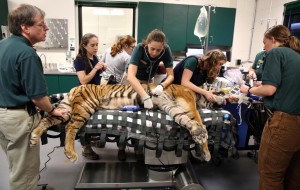
UC Davis veterinary surgeons prepare to operate on an ailing tiger in 2013. Photo from the Davis Enterprise
U.S. News & World Report has recognized the School of Veterinary Medicine at University of California, Davis, as the nation’s best veterinary school. The 2016 U.S. News & World Report Best Graduate Schools rankings also recognized many of UC Davis’ professional schools and graduate programs as among the nation’s best.
The UC Davis School of Veterinary Medicine, which annually cares for more than 48,000 animal patients and is educating more than 500 veterinary students plus residents and grad students, was ranked second in 2011, the last time vet schools were ranked by the magazine. The school runs a veterinary medical teaching hospital at UC Davis and satellite clinics in San Diego and the San Joaquin Valley community of Tulare.
Veterinary faculty members work to solve society’s most pressing health issues by collaborating with colleagues from human medicine and other disciplines. An example of its “one health” approach is a recent $100 million grant to the veterinary school to coordinate surveillance for disease-causing microbes, discovering new viruses and strengthening global health capacity in more than 20 countries.
Posted in Uncategorized
Leave a comment
California Ag Day, National Agriculture Week just around the corner – from the California Foundation for Ag in the Classroom
Each year, more than one-million students learn about the importance of agriculture through the efforts of California Foundation for Agriculture in the Classroom. This spring, Agriculture in the Classroom will partner with CDFA and the California Women for Agriculture to host California Ag Day 2015 as part of National Ag Week (March 15-21).
On March 18, the State Capitol will come alive with farm animals, educational displays, and entertainment all celebrating California’s great agricultural bounty during California Agriculture Day. The theme for the 2015 event is “California Agriculture: Breaking new Ground.” A focus will be the importance of soil health to our food supply and all of agriculture.
Ag Day is the agricultural community’s annual opportunity to educate and inspire the farmers and ranchers of tomorrow, showcase new technologies, and highlight the diversity of California agriculture.
California Department of Food and Agriculture (CDFA) Secretary Karen Ross, along with 12 other industry leaders, are members of the National Agriculture Week host committee. The host committee helps plan and promote special events throughout the state.
“Please join me and other leaders in agriculture as we support the education of our next generation of consumers and voters,” said Secretary Ross. “National Agriculture Week gives us the opportunity to celebrate agriculture, an industry that provides a safe, abundant, and affordable food supply, a strong economy, and a world of job opportunities.”
An additional Ag Week event will be held on March 19 at the Sacramento Kings’ Experience Center in Sacramento, to recognize student winners of Ag in the Classroom’s Imagine this… Story Writing Contest. Student authors will attend and read their stories from the newly published Imagine this… books to the audience. A southern California event will be held aboard The Queen Mary on April 2.
Since 1986, The California Foundation for Agriculture in the Classroom, a non-profit organization, has worked to promote a greater awareness of agriculture’s role in our daily lives to California’s teachers and students. The Foundation delivers exciting, standards-based curriculum that builds students’ knowledge of the farmers and ranchers who produce the food, clothing, and shelter they use every day. Agriculture in the Classroom programs reach far beyond the classroom walls and into the lives of California’s students and their families.
Posted in Uncategorized
Leave a comment


